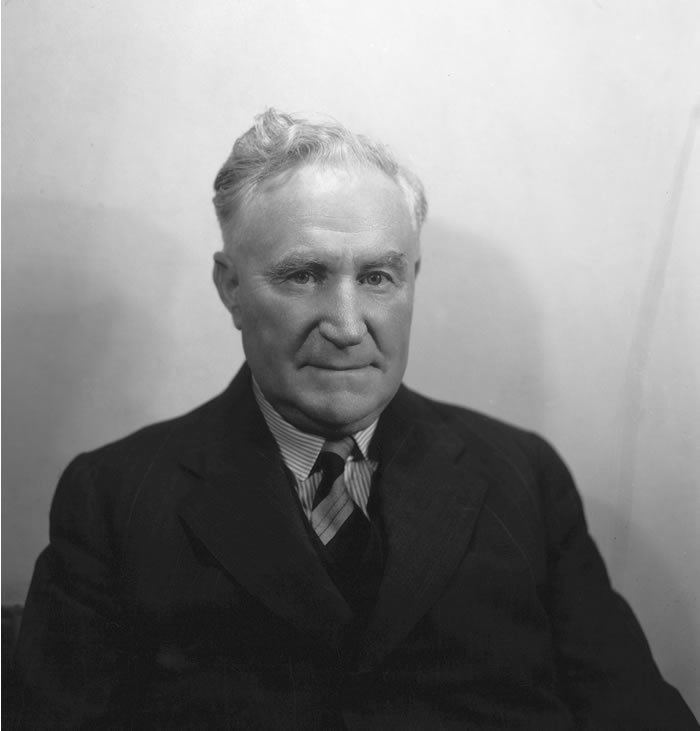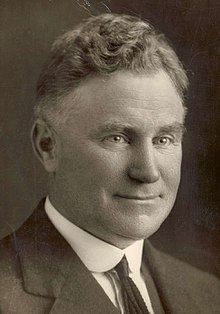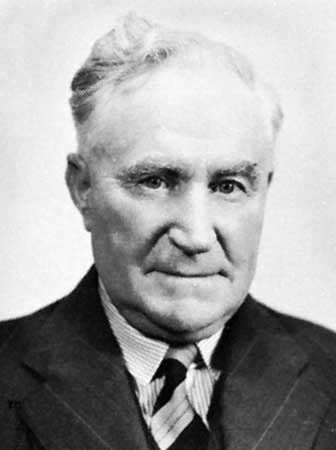Governor-General Lord Gowrie | Name Earle Page | |
 | ||
Died December 20, 1961, Sydney, Australia Party National Party of Australia Spouse Jean Page (m. 1959–2011), Ethel Blunt (m. 1906) Books Earle Page, The Wheat Industry Similar People | ||
Interview Earle Page
Sir Earle Christmas Grafton Page, (8 August 1880 – 20 December 1961) was an Australian politician who served as the Prime Minister of Australia for a brief period in April 1939, holding office in a caretaker capacity after the death of Joseph Lyons. He led the Country Party from 1921 to 1939, and served as a cabinet minister under six different prime ministers.
Contents
- Interview Earle Page
- Early life
- Pre political career
- Political career
- Prime Minister
- New states
- Return to the ministry
- Later life and death
- Personal life
- Earle Charles Page
- Honours
- References

Page was born in Grafton, New South Wales. He entered the University of Sydney at the age of 14, and completed his medical degree at the age of 20. Page initially worked as a surgeon at Sydney's Royal Prince Alfred Hospital, but later moved back to Grafton and opened a private practice. He soon became involved in local politics, and in 1915 purchased a part-share in The Daily Examiner, a local newspaper. Page gained prominence as an advocate of various development schemes for the Northern Rivers region, especially those involving hydroelectricity. He also helped found a movement for New England statehood.

In 1919, Page was elected to federal parliament representing the Division of Cowper. He joined the newly formed Country Party the following year, and initially served as the party whip; he replaced William McWilliams as party leader in April 1921. Page was a strong opponent of the policies of Billy Hughes, the prime minister and leader of the Nationalist Party. When the Country Party gained the balance of power at the 1922 election, he forced several concessions from the Nationalist Party in exchange for a coalition – most notably the replacement of Billy Hughes with Stanley Bruce. Page subsequently served as Treasurer of Australia in the Bruce Government from 1923 to 1929.

Page returned to cabinet after the 1934 election, when the Country Party entered a new coalition with the United Australia Party led by Joseph Lyons. He was appointed Minister for Commerce, and was the de facto deputy prime minister. When Lyons died in office in April 1939 (the first Australian prime minister to do so), Page was commissioned as his successor in a caretaker capacity while the UAP elected a new leader (Robert Menzies). He served as prime minister for just 19 days; only Frank Forde has held the position for a shorter term. Page had a poor relationship with Menzies, which led firstly to the Country Party withdrawing from the coalition and then to Page's removal as leader of the Country Party in September 1939. The coalition was eventually reconstituted, and Page served again as Minister for Commerce under Menzies and Arthur Fadden until the government's defeat in October 1941.

During World War II, Page served as a representative of John Curtin's Labor government in the United Kingdom. In 1949, he returned to cabinet as Minister for Health in Menzies' second government. Page retired from the ministry in 1956, but remained in parliament until losing his seat at the 1961 election; he died a short time later. He had been the "Father of Parliament" since 1952, and was an MP for just under 42 years, a mark surpassed only by Billy Hughes and Philip Ruddock.
Early life
Born in Grafton, New South Wales, Page was educated at Sydney Boys High School and the University of Sydney, where he initially enrolled in an arts degree, aged 14, before winning a scholarship at the end of the year and transferring to medicine. Page graduated in medicine at the top of his year in 1900.
Pre-political career
After graduating from university, Page worked at Sydney's Royal Prince Alfred Hospital as a house surgeon in 1901–1902 and a pathologist thereafter. At Royal Prince Alfred Hospital, he met Ethel Blunt, a nurse, whom he married in 1906.
In 1903, Page joined a private practice in Grafton; and, in 1904, he became one of the first people in the country to own a car. He practised in Sydney and Grafton before joining the Australian Army as a medical officer in the First World War, serving in Egypt.
After the war, Page went into farming and was elected Mayor of South Grafton.
Political career
In 1919 Page was elected to the House of Representatives from Cowper in northeastern New South Wales. He ran as a candidate of the Farmers and Settlers Association of New South Wales, one of several farmers' groups that won seats in that election. Shortly before parliament opened in 1920, the Farmers and Settlers Association merged with several other rural-based parties to form the Country Party. He became the party's leader in 1921, ousting William McWilliams. The young party found itself with the balance of power in the House after the 1922 election. The Nationalist government of Billy Hughes lost its majority, and could not govern without Country Party support. However, the Country Party had been formed partly due to discontent with Hughes' rural policy, and Page's animosity toward Hughes was such that he would not even consider supporting him. He demanded Hughes' resignation as the price for beginning negotiations with the Nationalists. As the Country Party was the Nationalists' only politically realistic coalition partner, Hughes stood down.
Page then began negotiations with Hughes' successor as leader of the Nationalists, Stanley Bruce. His terms were stiff; he wanted his Country Party to have five seats in an 11-man cabinet, including the post of Treasurer and the second rank in the ministry for himself. These demands were unprecedented for a prospective junior coalition partner in a Westminster system, and especially so for such a new party. Nonetheless, Bruce agreed rather than force another election. For all intents and purposes, Page was the first Deputy Prime Minister of Australia (a title that did not officially exist until 1968). Since then, the leader of the Country/National Party has been the second-ranking member in nearly every non-Labor government.
On 30 January 1924, as acting prime minister, Page chaired the first meeting of Federal Cabinet ever held in Canberra, at Yarralumla House. This was still three years before the opening of Parliament House and Canberra becoming the National Capital.
Page continued his professional medical practice. On 22 October 1924, he had to tell his best friend, Thomas Shorten Cole (1870–1957), the news that his wife Mary Ann Crane had just died on the operating table from complications of intestinal or stomach cancer, reputed by their daughter Dorothy May Cole to be "the worst day of his life".
He was a strong believer in orthodox finance and conservative policies, except where the welfare of farmers was concerned: then he was happy to see government money spent freely. He was also a "high protectionist": a supporter of high tariff barriers to protect Australian rural industries.
The Bruce-Page government was heavily defeated by Labor in 1929 (with Bruce losing his own seat), and Page went into opposition. In 1931, a group of dissident Labor MPs led by Joseph Lyons merged with the Nationalists to form the United Australia Party under Lyons' leadership. Lyons and The UAP–Country Coalition won a comprehensive victory in the 1931 election. However, the UAP was in a strong enough position (only four seats short of a majority) that Lyons was able to form an exclusively UAP minority government with confidence and supply support from the Country Party—to date, the last time that the party has not had any posts in a non-Labor government. In 1934, however, the UAP suffered an eight-seat swing, forcing Lyons to take the Country Party back into his government in a full-fledged Coalition. Page became Minister for Commerce. He was made a Knight Grand Cross of the Order of St Michael and St George (GCMG) in the New Year’s Day Honours of 1938. While nine Australian Prime Ministers were knighted (and Bruce was elevated to the peerage), Page is the only one who was knighted before becoming Prime Minister.
Prime Minister
When Lyons died suddenly in 1939, the Governor-General Lord Gowrie appointed Page as caretaker Prime Minister. He held the office for three weeks until the UAP elected former deputy leader Robert Menzies as its new leader, and hence Prime Minister.
Page had been close to Lyons, but disliked Menzies, whom he charged publicly with having been disloyal to Lyons. When Menzies was elected UAP leader, Page refused to serve under him, and made an extraordinary personal attack on him in the House, accusing him not only of ministerial incompetence but of physical cowardice (for failing to enlist during World War I). His party soon rebelled, though, and Page was deposed as Country Party leader in favour of Archie Cameron.
In 1940 Page and Menzies patched up their differences for the sake of the war effort, and Page returned to the cabinet as Minister for Commerce. Nevertheless, Page's accusations were not forgotten and were occasionally raised in parliament by Menzies' opponents (notably Eddie Ward). In 1941, the government fell; and Page spent the eight years of the Curtin and Chifley Labor governments on the opposition backbench. He was made a Companion of Honour (CH) in June 1942.
New states
In 1949, Page put forward a discussion paper on the redrawing of state boundaries. He proposed that Australia would be divided into 12 states. Queensland would be split into four states: Eden–Monaro and East Gippsland would become another state, Mount Gambier to Mildura and Cape Otway another state, and the Northern Territory divided into two. Page had a particular interest in forming a new state of New England, in his own area of northeast New South Wales.
Return to the ministry
Menzies returned to the Prime Ministership in 1949, and Page was made Minister for Health. He held this post until 1956, when he was 76, then retired to the backbench. Upon the death of Billy Hughes in October 1952, Page became the Father of the House of Representatives and Father of the Parliament.
Later life and death
Page was the first Chancellor of the University of New England, which was established in 1954.
By the 1961 election, Page was gravely ill, suffering from lung cancer. Although he was too sick to actively campaign, Page refused to even consider retiring from Parliament and soldiered on for his 17th general election. In one of the great upsets of Australian electoral history, he lost his seat to Labor challenger Frank McGuren, whom he had defeated soundly in 1958. Page had gone into the election holding Cowper with what appeared to be an insurmountable 11-point majority, but McGuren managed to win the seat on a swing of 13%.
Page had campaigned sporadically before going to Royal Prince Alfred Hospital in Sydney for emergency surgery. He went comatose a few days before the election and never regained consciousness. He died on 20 December, 11 days after the election, without ever knowing that he had been defeated.
Page had represented Cowper for just four days short of 42 years, making him the longest-serving Australian federal parliamentarian who represented the same seat throughout his career. Only Billy Hughes and Philip Ruddock have served in Parliament longer than Page, but Hughes represented four different seats in two states while Ruddock has represented three seats in New South Wales.
Personal life
Page and his wife Ethel had five children: a daughter Mary born in 1909 and four sons. Lady Page died at Elizabeth Bay in 1958.
On 20 July 1959 at St Paul's Cathedral, London, Page married his secretary, Jean Thomas who was 32 years his junior. Bruce was his best man at the ceremony. The second Lady Page, died on 20 June 2011, 60 years after her husbands demise. Lady Page's ashes are interred at Northern Suburbs Crematorium. Page's grandson, Don Page, was a National MP in the NSW Parliament and served as Deputy Leader of the NSW Nationals from 2003 to 2007. Another grandson is Canberra poet Geoff Page. His nephew was Robert Page, a soldier and war hero.
Earle Charles Page
Page's oldest son, Earle Charles Page, was born in 1911 at South Grafton and attended Newington College (1922–1927), during the headmastership of the Rev Dr Charles Prescott. At Newington, he won the Wigram Allen Scholarship in 1927, awarded by Sir George Wigram Allen, for general proficiency, with Dave Cowper receiving it for classics and Bill Morrow for mathematics in the same year. In 1932, Page graduated in veterinary science from the University of Sydney. He played Rugby Union and was selected for Combined Australian Universities and, as a reserve, for NSW.
Earle Charles Page was managing a rural property for his father at the time of his death in 1933 by lightning strike.
The other Page boys were Donald (b. 1912), Iven (b. 1914) and Douglas (b. 1916).
